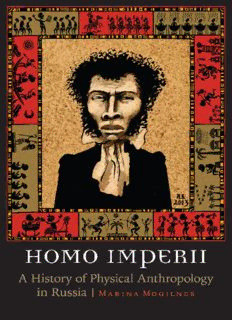
Homo Imperii: A History of Physical Anthropology in Russia PDF
Preview Homo Imperii: A History of Physical Anthropology in Russia
H(cid:38)(cid:36)(cid:38)(cid:3)I(cid:36)(cid:39)(cid:28)(cid:41)(cid:32)(cid:32) Critical Studies in the History of Anthropology (cid:42)(cid:28)(cid:41)(cid:32)(cid:28)(cid:42)(cid:3)(cid:28)(cid:27)(cid:32)(cid:43)(cid:38)(cid:41)(cid:42) Regna Darnell Stephen O. Murray H(cid:38)(cid:36)(cid:38) (cid:3)I (cid:36)(cid:39)(cid:28)(cid:41)(cid:32)(cid:32) A History of Physical Anthropology in Russia | (cid:36)(cid:24)(cid:41)(cid:32)(cid:37)(cid:24)(cid:3)(cid:36)(cid:38)(cid:30)(cid:32)(cid:35)(cid:37)(cid:28)(cid:41) University of Nebraska Press Lincoln & London © 2013 by the Board of Regents of the University of Nebraska All rights reserved Manufactured in the United States of America (cid:55)(cid:75)(cid:72)(cid:3)(cid:192)(cid:85)(cid:86)(cid:87)(cid:3)(cid:89)(cid:72)(cid:85)(cid:86)(cid:76)(cid:82)(cid:81)(cid:3)(cid:82)(cid:73)(cid:3)(cid:87)(cid:75)(cid:76)(cid:86)(cid:3)(cid:69)(cid:82)(cid:82)(cid:78)(cid:3)(cid:75)(cid:68)(cid:86)(cid:3)(cid:69)(cid:72)(cid:72)(cid:81)(cid:3)(cid:86)(cid:88)(cid:69)(cid:86)(cid:87)(cid:68)(cid:81)(cid:87)(cid:76)(cid:68)(cid:79)(cid:79)(cid:92)(cid:3)(cid:85)(cid:72)(cid:89)(cid:76)(cid:86)(cid:72)(cid:71)(cid:3)(cid:69)(cid:92)(cid:3)(cid:87)(cid:75)(cid:72)(cid:3) author and was originally published in Russian at the New Literary Review Publishing House in Moscow as (cid:43)(cid:82)(cid:80)(cid:82)(cid:3)(cid:76)(cid:80)(cid:83)(cid:72)(cid:85)(cid:76)(cid:76)(cid:29)(cid:3)(cid:76)(cid:86)(cid:87)(cid:82)(cid:85)(cid:76)(cid:76)(cid:68)(cid:3)(cid:192)(cid:93)(cid:76)(cid:70)(cid:75)(cid:72)(cid:86)(cid:78)(cid:82)(cid:76)(cid:3) (cid:68)(cid:81)(cid:87)(cid:85)(cid:82)(cid:83)(cid:82)(cid:79)(cid:82)(cid:74)(cid:76)(cid:76)(cid:3)(cid:89)(cid:3)(cid:53)(cid:82)(cid:86)(cid:86)(cid:76)(cid:76)(cid:3)(cid:11)(cid:78)(cid:82)(cid:81)(cid:72)(cid:87)(cid:86)(cid:3)(cid:59)(cid:44)(cid:59)(cid:178)(cid:81)(cid:68)(cid:70)(cid:75)(cid:68)(cid:79)(cid:82)(cid:3)(cid:59)(cid:59)(cid:3)(cid:89)(cid:72)(cid:78)(cid:68)(cid:12), © 2008 by Novoe Literaturnoe Obozrenie, Moskva. Library of Congress Cataloging-in-Publication Data Mogilner, Marina, author. Homo imperii: a history of physical anthropology in Russia / Marina Mogilner. pages: illustrations; cm.—(Critical studies in the history of anthropology) Revised version of the work originally published in Russian under (cid:87)(cid:76)(cid:87)(cid:79)(cid:72)(cid:29)(cid:3)(cid:43)(cid:82)(cid:80)(cid:82)(cid:3)(cid:76)(cid:80)(cid:83)(cid:72)(cid:85)(cid:76)(cid:76)(cid:29)(cid:3)(cid:76)(cid:86)(cid:87)(cid:82)(cid:85)(cid:76)(cid:76)(cid:68)(cid:3)(cid:192)(cid:93)(cid:76)(cid:70)(cid:75)(cid:72)(cid:86)(cid:78)(cid:82)(cid:76)(cid:3)(cid:68)(cid:81)(cid:87)(cid:85)(cid:82)(cid:83)(cid:82)(cid:79)(cid:82)(cid:74)(cid:76)(cid:76)(cid:3)(cid:89)(cid:3)(cid:53)(cid:82)(cid:86)(cid:86)(cid:76)(cid:76)(cid:3)(cid:11)(cid:78)(cid:82)(cid:81)(cid:72)(cid:87)(cid:86)(cid:3) XIX—nachalo XX veka). Includes bibliographical references and index. (cid:32)(cid:42)(cid:25)(cid:37) 978-0-8032-3978-4 (cloth: alkaline paper) 1. Physical anthropology—Russia—History—20th century. 2. Physical anthropology—Soviet Union—History. I. Title. (cid:30)(cid:37)50.45.(cid:41)8(cid:36)64 2013 599.90947—dc23 2013005803 Set in Iowan by Laura Wellington. Contents List of Illustrations vii Acknowledgments ix Series Editors’ Introduction xiii Introduction: The Science of Imperial Modernity 1 (cid:39)(cid:24)(cid:41)(cid:43)(cid:3)(cid:11). Paradoxes of Institutionalization 1. Academic Genealogy and Social Contexts of the “Atypical Science” 17 2. Anthropology as a “Regular Science”: Kafedra 34 3. Anthropology as a Network Science: Society 54 (cid:39)(cid:24)(cid:41)(cid:43)(cid:3)(cid:12). The Liberal Anthropology of Imperial Diversity: Apolitical Politics (cid:23)(cid:17)(cid:3)(cid:36)(cid:79)(cid:72)(cid:78)(cid:86)(cid:72)(cid:76)(cid:3)(cid:44)(cid:89)(cid:68)(cid:81)(cid:82)(cid:89)(cid:86)(cid:78)(cid:76)(cid:76)(cid:183)(cid:86)(cid:3)(cid:36)(cid:81)(cid:87)(cid:75)(cid:85)(cid:82)(cid:83)(cid:82)(cid:79)(cid:82)(cid:74)(cid:76)(cid:70)(cid:68)(cid:79)(cid:3)(cid:38)(cid:79)(cid:68)(cid:86)(cid:86)(cid:76)(cid:192)(cid:70)(cid:68)(cid:87)(cid:76)(cid:82)(cid:81)(cid:3) of the Family of “Racial Relatives” 101 5. “Russians” in the Language of Liberal Anthropology 121 6. Dmitrii Anuchin’s Liberal Anthropology 133 (cid:39)(cid:24)(cid:41)(cid:43)(cid:3)(cid:13). Anthropology of Russian Imperial Nationalism 7. Ivan Sikorsky and His “Imperial Situation” 167 8. Academic Racism and “Russian National Science” 185 (cid:39)(cid:24)(cid:41)(cid:43)(cid:3)(cid:14). Anthropology of Russian Multinationalism 9. The Space between “Empire” and “Nation” 201 10. “Jewish Physiognomy,” the “Jewish Question,” and Russian Race Science between Inclusion and Exclusion 217 11. A “Dysfunctional” Colonial Anthropology of Imperial Brains 251 (cid:39)(cid:24)(cid:41)(cid:43)(cid:3)(cid:15). Russian Military Anthropology: From Army-as-Empire to Army-as-Nation 12. Military Mobilization of Diversity Studies 269 13. The Imperial Army through National Lenses 279 14. Nation Instead of Empire 286 (cid:39)(cid:24)(cid:41)(cid:43)(cid:3)(cid:16). Race and Social Imagination 15. The Discovery of Population Politics and Sociobiological Discourses in Russia 297 16. Meticization as Modernization, or the Sociobiological Utopias of Ivan Ivanovich Pantiukhov 310 17. The Criminal Anthropology of Imperial Society 328 Conclusion: Did Russian Physical Anthropology Become Soviet? 347 Notes 375 Index 473 Illustrations 1. Model of a mammoth from the Anthropological Exhibition of 1879 29 2. Lapps exhibit in the Anthropological Exhibition of 1879 30 3. Anthropologist taking measurements in a lab, 1904 46 4. Eduard Yul’evich Petri 79 5. Dmitrii Andreevich Koropchevskii 89 6. Map of relative distribution of brunets and map of head index, in Italy 103 7. Map of the distribution of height of male population in France 104 8. Map of average height of military conscripts in Russia’s provinces 105 9. A Kirgyz woman, 1903 109 10. A Kirgyz man, 1903 109 11. Title page of A. A. Ivanovskii’s published dissertation, 1904 111 12. Viktor Vladimirovich Vorob’ev 123 13. Types of Great Russian peasants 1913 126–130 14. Dmitrii Nikolaevich Anuchin 134 15. A Pole from Podolia Province, 1901 207 16. A Young Polish Jew from Kholm 228 17. A Polish Jew from Kholm 228 18. A Russian Jew from Minsk 229 19. A Russian Jew from Samarkand 230 20. A Caucasian Jewish woman from Kuba, of Baku Region 231 21. A Jewish woman from Southern Russia 232 22. A Jew from Rodos Island 233 23. A Jerusalem Jew 234 24. Anthropological examination of the skull 254 25. Police anthropometry, 1903 330 Acknowledgments When someone works on a project as long as I have worked on my study of Russian race science, the list of people and institutions that deserve to be mentioned in the book inevitably exceeds all possible dimensions. Indeed, I am indebted to dozens of my col- leagues in Russia, Europe, and the United States for their inspir- ing comments and provocative criticisms. I have already had the opportunity to thank many of them in the earlier Russian edition of this book (Moscow: New Literary Review, 2008). The pres- ent English-language edition is not only my own translation of the Russian original—it is actually a new book, containing much new material and many new interpretations inspired by the com- ments and friendly criticisms of my readers-colleagues. Therefore, I want to express my deep gratitude to those who created an al- most ideal intellectual situation for me, as an author who, after having published a book on Russian physical anthropology, still continues pursuing the problem of “race” in the Russian imperial and early Soviet contexts. This situation of ongoing fruitful dis- cussion stimulated me to reconsider some of my early approach- es as well as to better substantiate some positions that remained important to me. I should probably start with Sergei Kan, who read my Russian book and insisted that the English version should be published in the University of Nebraska Press anthropologi- cal series. The challenge of writing not for “Russianists” and not only for historians but for a wider professional audience required me to unpack what I had deemed as “self-evident,” and while do- ing this I actually faced new research questions and new oppor- tunities for interpreting my material. In this regard, I also want ix
Description: